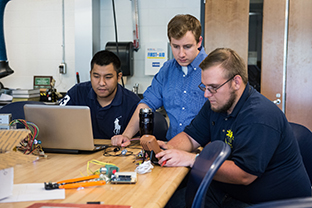May 30, 2017
SVSU engineering students aiming to assist in pet surgery recovery with automated intensive care unit
 When dogs undergo surgery, veterinarians often must suture a nasal oxygen catheter to the animal, making for an uncomfortable recovery. Four Saginaw Valley State University electrical engineering students are working to ensure that is no longer necessary for a Saginaw County pet emergency hospital.
When dogs undergo surgery, veterinarians often must suture a nasal oxygen catheter to the animal, making for an uncomfortable recovery. Four Saginaw Valley State University electrical engineering students are working to ensure that is no longer necessary for a Saginaw County pet emergency hospital.
Students Amen Al Abbas of Saudi Arabia; Jonathan Claus of Hawks, Michigan; Michael Papesh of Saginaw, Michigan; and Zwe Thiha of Myanmar are in the development phase of creating an automated intensive care unit for Great Lakes Pet Emergencies in Carrollton Township. The unit is a three-pet sealed cage with oxygen sensors and temperature and air filtering controls.
“There is an issue where if we program something wrong, we do something wrong, the pet’s health could possibly be at risk,” Claus said. “So there’s definitely a strain to ourselves of making sure that we do everything with the utmost care and reliability.”
The seniors are halfway through their capstone project. In the first semester, the students plan their project, conduct a feasibility student and, in some cases, begin programming. The students spend much of their second semester working on and testing their prototype.
Some projects are completely student-driven, while others feature student groups collaborating with an external client such as Great Lakes Pet Emergencies. The pet ICU is the latter; Ryan Dowling, the operations manager at the hospital, proposed the project.
“The best solution in the industry is the ICU cage,” Dowling said. “We needed some expertise on how to create an electronic control system, and the best way to do is to reach out to people in that field. We thought it’d be a good opportunity for students to get a hands-on project.”
Dowling, who meets with the students regularly, said his experience working with SVSU students on four separate projects has been “nothing short of fantastic.”
“Even if they come up with a challenge on how to fix something, they don’t hesitate to ask the right people and get the right answers,” Dowling said. “And they do it rather quickly. As an outside company, it’s been phenomenal. There is an incredibly bright group of students in the engineering department.”
Along the way in their first semester working on the project, the students determined they needed a new, more expensive oxygen sensor. Dowling agreed to make the purchase.
“Clients have to make a tradeoff where either the cost is important or the reliability is important,” said Rajani Muraleedharan, SVSU assistant professor of electrical and computer engineering and the faculty adviser for the ICU project. “So for their project, it is life. It is not human, but it’s still a pet. So they have to make sure they make the right call.”
The fact that pets will rely on the ICU for their recovery, as well as the real-world functionality of the project, was appealing to Claus.
“Everyone goes into senior design knowing that this is our last real chance for discovering what we don’t know and for getting that experience that’s really going to translate into our lives as engineers,” he said. “Whereas some projects might get built, they’re on display, they get shoved into a cabinet somewhere, they gather dust, we’re doing an actual job that someone would contract engineers to do. … This is going to be used, this is something that should last and that we are responsible for.”
Usability, then, will be a primary goal, as those working in the pet hospital do not share the same engineering background as the students.
“It has to be very easy to use,” Muraleedharan said. “They’re not going to know anything about programming. All they’re going to see is a good graphical interface, and that’s all they’re going to have to work with. So it has to be simple, it has to be very clear, and it has to do its job the right way.”
Testing also will prove key. Dowling will handle testing with live animals, but the students must ensure the network they build, with different professional programming languages, communicates correctly. Each partition of the cage will have its own unit.
“Getting all that to mesh is tricky,” Claus said. “This is something normally done by somebody with years of experience. This is something we have touched on in school, but never to this level.”
Thiha, who is from the Asian country of Myanmar, likens using programming to make technology function to “real world magic.”
“That’s how I see it, it’s like casting a spell,” he said. “It’s just working.”
Capstone projects are important opportunities for international students such as Thiha and Al Abbas, who is from Saudi Arabia, to learn real-world skills and complete a project that they can feature on a resume.
“They both get to work with American kids and get to know the work ethic,” Muraleedharan said. “Sometimes, international students don’t get to be an intern anywhere. So this is their best choice to make.”
Another aspect of the students’ work in their first semester was considering whether their methodology for the project should share any similarities to existing similar systems, which cost a minimum of about $9,000. Not factoring in the cost of the cage, Dowling has poured in more than $2,000 into the project, but this one is different than those on the market because it is tailor-made to what Great Lakes Pet Emergencies needs.
“I’d like to believe that when it’s done, it’ll be at least comparable to anyone on the market and as reliable,” Claus said.
“I think they will be successful,” Muraleedharan said. “But they will be facing a few road blocks getting there.”
